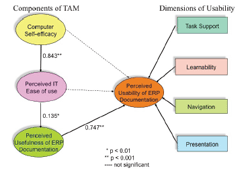
Enterprise resource planning (ERP) Systems have a reputation for being complex, problematic to implement and difficult for users to learn. The technology puts pressure on organizations to change their processes, leaving users struggling to relearn their jobs and day-to-day tasks even while coping with non-intuitive new software.11 Training should provide documentation of the transformed processes to help users overcome the tendency to cling to established routines. The usability of documentation affects the effectiveness of training and could result in faster payback on the ERP investment. Moreover, documentation should go beyond step-by-step instructions by explaining the rationale for the process embedded in the ERP software. Understanding the rationale facilitates learning and competence for novice users and so is critical for technology acceptance.
The research streams on the technology acceptance model (TAM)4 and usability have traditionally been independent. Yet both streams of research focus on the users’ perception of technology. A unified model would clarify the relationship between usability and technology acceptance. In this study we proposed a unified model to investigate the relationship between perceptual measures used in TAM studies and perceived usability of ERP documentation (See Figure 1). Results from a survey of ERP users at a large university showed that perceived usefulness of the documentation had a strong relationship with its perceived usability. Also users rated the documentation poorly for helping them understand business processes. Documentation usability would improve with an emphasis on support for relevant new tasks and explanation for the rationale of the transformed process.2,4,6
Documentation Usability
Documentation for software users has evolved from paper-based training manuals to online help. Early software-oriented manuals provided a reference to commands in the system, but did not help people complete their tasks.10 In contrast, later task-oriented manuals specified all the steps to complete a task. While they gave more explicit assistance, critics believed the “recipe” approach would lead to deskilling and a decrease in discretion,1 since users may not see the point of mindlessly following instructions. Moreover, specifying detailed directions resulted in task-oriented manuals becoming bulky, which often discouraged adults, who resisted new learning.10 An alternative approach was the minimalist manual, which provided considerably fewer instructional details. Research reported that a minimalist manual with 75% fewer pages than a task-oriented manual reduced learning time by 40%. Nevertheless such learning by self-discovery is ineffective and unsatisfying for some users despite proposed advantages of reducing information overload and search effort, coordinating user attention, giving the learner more to think about, helping motivate users to start using the software, and reducing user errors.1,10
Most people when they are stumped using software prefer to get help from another person rather than read documentation.2,10 However, individual help is often unavailable and is an expensive form of support. Therefore finding ways to improve documentation usability is an important issue for both practice and research. Increasingly documentation is available online, taking advantage of lower printing costs and easier distribution. Online delivery also improves documentation usability by providing more current content and better presentation with hypertext and color. Furthermore, integrating documentation into software and integrating design and documentation roles hold promise for usability improvements.10 Yet ERP vendors cannot include organization specific details in documentation, hence organizations themselves need to work on this aspect of usability improvement.
TAM and usability. TAM shows that perceived usefulness (PU) and perceived ease of use (PEOU) are important for technology acceptance.4 Furthermore computer self-efficacy (CSE) affects PEOU.12 The model proposed in Figure 1 assesses the impact of CSE, PEOU of IT, and PU of the documentation on the perceived usability of ERP documentation.
Computer self-efficacy. Research on the effectiveness of the software learning process has shown the importance of the learner’s CSE.3 CSE is an individual’s judgment of one’s ability to use a computer. Individuals with high self-efficacy are highly motivated to be persistent in their achievement of a goal, and not easily discouraged by failure. Users with high CSE are less likely to become frustrated with technology. Furthermore, TAM research has shown that higher CSE is associated with higher PEOU of IT.12 This study proposes that users with higher CSE would find ERP documentation easier to follow and understand, and hence more usable.
Perceived ease of use. PEOU is the extent to which a person believes that using a technology will be free of effort.12 PEOU is influenced by CSE and other characteristics of the user and is important for determining PU, acceptance and use of technology. Our model expects users who perceive IT in general as easier to use find documentation easier to follow and understand, and hence more usable.
Perceived usefulness. The PU of ERP training manuals and online documentation for users depends on going beyond step-by-step instructions for a task by explaining the logic in the software functionality. In an ERP implementation, understanding the logic of the business processes is important for helping users adapt to changes in their tasks. Users will persevere in their attempts to reach a goal if it is useful and important to them, even if an application or its documentation is difficult to use.2,4 Consequently, we expect that PU of the documentation contributes to perceived usability of the documentation, especially the task support dimension.
TAM research also shows that PEOU of technology affects its PU.4 Users that consider technology in general difficult to use will rationalize that it is not useful. In this study, the documentation, printed or online, was a component of the ERP system. We expect that the users’ PEOU of technology in general affected their PU of the ERP documentation.
Perceived usability. Early pioneers in the usability field pointed to the fundamental principles of good design, such as having a good conceptual model before designing a product, using consistency and speaking the users’ language.9 Usability in simple terms is making sure that something works well, and that a person of average ability can use it for its intended purpose without frustration.8 Usability has been applied to the design of everyday products, as well as entire software systems, including the user interface, supporting documentation and help system.7,9
A computer application can have adequate functionality, be reliable, maintainable, and meet technical requirements, and yet not be usable. Functionality and usability are both task related and people related, but are complementary since access to functionality can be limited by poor usability.6 Functions need to match task requirements and people need to understand what the functions do and how to use them. Grouping related commands into menus, other examples of good interface design and documentation help overcome the conflict between power and ease of use to enhance both usability and functionality.
ERP systems are rich in functionality. However, a richer system can provide less effective functionality if its perceived usability is poor. Users might resort to manual work-arounds or even avoid using the system altogether. Moreover, powerful functionality, complexity and flexibility, such as in ERP systems, can induce confusion, frustration, failure and other negative emotional responses, which lead to errors, especially for novices.26 Novices do not understand the cause of the error and are unable to understand how to appropriately respond to the error; therefore they may act in ways that make the error worse.2 On the other hand, small improvements in usability can translate into large cost savings (from reducing errors, training and support), increased user productivity and greater satisfaction.6,7 For example, on-line help and other improvements to a system reduced task completion times and error rates by 25%, reducing the workload by 17 weeks per employee per year.6
The International Standards Organization defines usability as “the extent to which a product can be used by specified users to achieve specified goals with effectiveness, efficiency, and satisfaction in a specified context of use.” Effectiveness measures the “goodness” of the output by the user or whether users can perform their tasks, whereas efficiency has more to do with the quantity of work output in relation to the time, effort and resources involved. The satisfaction of a user is a measure of the user’s attitudes and perceptions about the usability of an item. Products with good usability allow users to complete their tasks well in a timely manner with a minimum of frustration.
Similar to prior research, this study uses a practitioner instrument to assess usability. The items assessing usability of the ERP documentation were adapted from the Questionnaire for Usability Evaluation (QUE), designed by US WEST Information Technologies to assess the usability of interfaces. QUE was selected because of its theoretical support, practicality, and similarity to other instruments and on the recommendation of a practicing usability expert. The dimensions of usability assessed using QUE are navigation, presentation, learnability and task support.
Navigation refers to the methods by which users move around in a system or documentation. Usability research recognizes the importance of navigability.5,8 The documentation should be easy to search and should facilitate finding what is needed quickly and efficiently without too many steps.2 A printed manual is more difficult to design for easy navigation than online documentation because it has less flexibility, and lacks a search engine or hyperlinks.
Presentation. Effective presentation uses good graphic design principles for fonts, colors, layout, graphics clarity and white space, while making sure not to distract users from their primary task.5 Presentation organized with tabs, a table of contents and index help with navigation.8 Structure and organization facilitate ease of use. Online documentation can take advantage of color in presentation since it is not as expensive as in printed manuals.
Learnability. Learning is an important issue for usability.5 Unnecessary technical jargon and confusing acronyms deter learning,2 so terminology should use the language of its users.7 In QUE, learnability is defined as how easy a system is to learn so that users can begin to get their work done quickly. In this study, learnability is applied to the helpfulness of the printed and online documentation for users in learning the ERP system. Users may avoid using manuals that are not concise. Too many details are likely to hinder learning because of frustration and stress from information overload. A potential solution to information overload is the use of hyperlinks in online documentation.
Task support. Task support refers to the capability to help users perform their tasks quickly, effectively, and economically.6,8 To do this documentation should focus on the user’s task, and list concrete steps to be carried out. The content should be relevant, have the appropriate depth and breadth, and provide current and timely information. Tailoring content to users’ tasks would be effective for increasing relevance. Explaining the rationale for the process would help users understand the purpose of the task.
In summary, navigation, presentation, learnability, and task support dimensions contribute to users’ effectiveness, efficiency and satisfaction. While the terminology sometimes varies, QUE dimensions are analogous to those proposed by usability experts and researchers.2,5,7,8
Survey
A Web-based survey was designed to investigate the relationship between TAM measures and ERP documentation usability (see model in Figure 1). Post-implementation data were collected from Peoplesoft ERP users at a large U.S. university. Users received a printed manual during mandatory classroom training. The manuals consisted of over 400 pages in a loose-leaf binder of predominantly screen shots and instructions for the new processes. Users received updates by email and could download the updated manuals from a secure site. About 85 step-by-step guides were customized for the project and delivered online as user alerts.
An email alert notified about 1200 ERP users to participate in the survey, and a follow-up email alert reminded users a few weeks later. After discarding incomplete responses from the 378 surveys received, we had 289 usable responses. Data analysis using partial least squares (PLS) determined the reliability and validity of the measures as well as statistical significance of the relationships in the model.
Survey measures (see Table 1) were on a 7-point Likert scale from “strongly disagree” to “strongly agree.” The usability questions in the survey included measures based on QUE and prior studies.2,5,7,8 CSE3 and TAM questions for PEOU and PU were adapted from measures validated in prior research.4,12
Results
The respondents were 88% female and 66% had been employed at the university for more than 5 years. The ERP project changed users’ tasks dramatically because many paper-based processes became centralized and electronic requiring ERP data entry. Although process changes are better understood if the logic is apparent, responses to the usability task support survey question on documentation “helping users to understand business processes” had an average of only 3.74 (standard deviation S.D. is 1.54) on the 7-point scale, the lowest for any of the measures. This result underscores the importance of explaining the rationale for the process change.
The measures had high reliability for each construct (0.892 for CSE, 0.931 for PEOU, 0.935 for PU and 0.947 for usability), establishing confidence in the measuring instrument. The construct averages were highest for PEOU of IT (5.61, S.D. 0.25), and lowest for perceived usability of the ERP documentation (4.26, S.D. 0.32). This indicates that users did not rate the usability of the documentation as very high. There was a strong relationship between CSE and PEOU (0.843 p< 0.001) and a moderate relationship between PEOU of IT and PU of the ERP documentation (0.135 p<0.01), confirming findings in the TAM literature.12 There was also a strong relationship between PU of the documentation and perceived usability of the documentation (0.747 p<0.001). This signified that users who found the documentation useful were more likely to make use of it to efficiently and effectively do their tasks. The strong relationship between a TAM measure (PU) and perceived usability shows that converging the two streams of research is justified. PEOU and CSE had weak relationships with perceived usability. Both pertained to technology in general rather than specifically to the ERP documentation. These results imply that users were not having difficulty with the usability of the documentation because of low CSE or because they thought technology in general was difficult to use.
Conclusion
This study validates a measuring instrument for perceived usability, and finds that the perceived usefulness of ERP documentation strongly affects its perceived usability. Our contribution clarifies the relationship between perceived usability and PU from the technology acceptance model. Specifically, when users perceived the ERP documentation as useful they were more likely to leverage it for task support efficiently, effectively and with satisfaction.2,4,6 The documentation this study investigated included online help as suggested by2 in addition to printed manuals. Although the step-by-step guides were valuable for providing instructions for organization specific tasks, the survey responses reveal that the documentation was weaker in explaining the logic and rationale of the business processes. To prevent ERP users from becoming frustrated with the documentation and turning to more expensive forms of support such as the helpdesk or other users, the documentation should facilitate learning by explaining the rationale for transformed processes as well as emphasize support for new tasks.1,2,10 Improving documentation usability would increase training effectiveness, user satisfaction, productivity and the potential return on ERP investment, as well as decrease the pain and cost of implementation.2,7





Join the Discussion (0)
Become a Member or Sign In to Post a Comment